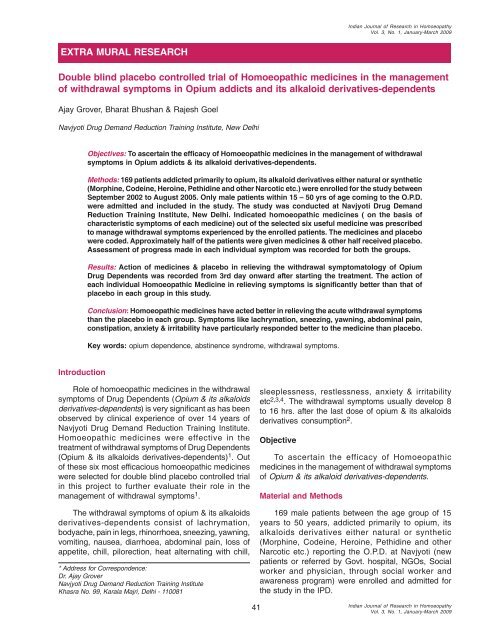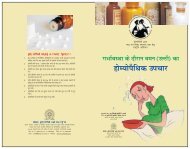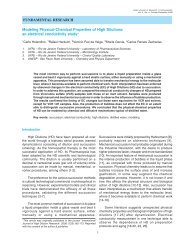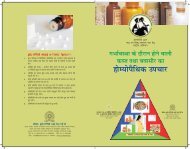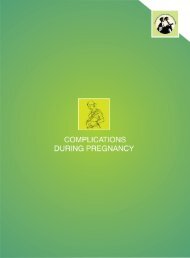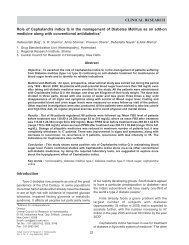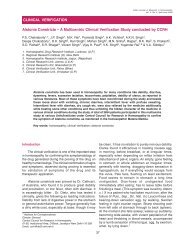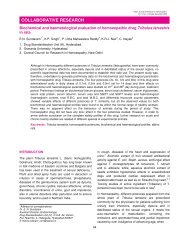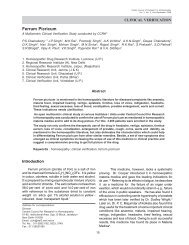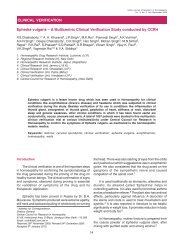Double blind placebo controlled trial of Homoeopathic medicines in ...
Double blind placebo controlled trial of Homoeopathic medicines in ...
Double blind placebo controlled trial of Homoeopathic medicines in ...
Create successful ePaper yourself
Turn your PDF publications into a flip-book with our unique Google optimized e-Paper software.
EXTRA MURAL RESEARCH<br />
41<br />
Indian Journal <strong>of</strong> Research <strong>in</strong> Homoeopathy<br />
Vol. 3, No. 1, January-March 2009<br />
<strong>Double</strong> <strong>bl<strong>in</strong>d</strong> <strong>placebo</strong> <strong>controlled</strong> <strong>trial</strong> <strong>of</strong> <strong>Homoeopathic</strong> <strong>medic<strong>in</strong>es</strong> <strong>in</strong> the management<br />
<strong>of</strong> withdrawal symptoms <strong>in</strong> Opium addicts and its alkaloid derivatives-dependents<br />
Ajay Grover, Bharat Bhushan & Rajesh Goel<br />
Navjyoti Drug Demand Reduction Tra<strong>in</strong><strong>in</strong>g Institute, New Delhi<br />
Introduction<br />
Objectives: To ascerta<strong>in</strong> the efficacy <strong>of</strong> <strong>Homoeopathic</strong> <strong>medic<strong>in</strong>es</strong> <strong>in</strong> the management <strong>of</strong> withdrawal<br />
symptoms <strong>in</strong> Opium addicts & its alkaloid derivatives-dependents.<br />
Methods: 169 patients addicted primarily to opium, its alkaloid derivatives either natural or synthetic<br />
(Morph<strong>in</strong>e, Code<strong>in</strong>e, Hero<strong>in</strong>e, Pethid<strong>in</strong>e and other Narcotic etc.) were enrolled for the study between<br />
September 2002 to August 2005. Only male patients with<strong>in</strong> 15 – 50 yrs <strong>of</strong> age com<strong>in</strong>g to the O.P.D.<br />
were admitted and <strong>in</strong>cluded <strong>in</strong> the study. The study was conducted at Navjyoti Drug Demand<br />
Reduction Tra<strong>in</strong><strong>in</strong>g Institute, New Delhi. Indicated homoeopathic <strong>medic<strong>in</strong>es</strong> ( on the basis <strong>of</strong><br />
characteristic symptoms <strong>of</strong> each medic<strong>in</strong>e) out <strong>of</strong> the selected six useful medic<strong>in</strong>e was prescribed<br />
to manage withdrawal symptoms experienced by the enrolled patients. The <strong>medic<strong>in</strong>es</strong> and <strong>placebo</strong><br />
were coded. Approximately half <strong>of</strong> the patients were given <strong>medic<strong>in</strong>es</strong> & other half received <strong>placebo</strong>.<br />
Assessment <strong>of</strong> progress made <strong>in</strong> each <strong>in</strong>dividual symptom was recorded for both the groups.<br />
Results: Action <strong>of</strong> <strong>medic<strong>in</strong>es</strong> & <strong>placebo</strong> <strong>in</strong> reliev<strong>in</strong>g the withdrawal symptomatology <strong>of</strong> Opium<br />
Drug Dependents was recorded from 3rd day onward after start<strong>in</strong>g the treatment. The action <strong>of</strong><br />
each <strong>in</strong>dividual <strong>Homoeopathic</strong> Medic<strong>in</strong>e <strong>in</strong> reliev<strong>in</strong>g symptoms is significantly better than that <strong>of</strong><br />
<strong>placebo</strong> <strong>in</strong> each group <strong>in</strong> this study.<br />
Conclusion: <strong>Homoeopathic</strong> <strong>medic<strong>in</strong>es</strong> have acted better <strong>in</strong> reliev<strong>in</strong>g the acute withdrawal symptoms<br />
than the <strong>placebo</strong> <strong>in</strong> each group. Symptoms like lachrymation, sneez<strong>in</strong>g, yawn<strong>in</strong>g, abdom<strong>in</strong>al pa<strong>in</strong>,<br />
constipation, anxiety & irritability have particularly responded better to the medic<strong>in</strong>e than <strong>placebo</strong>.<br />
Key words: opium dependence, abst<strong>in</strong>ence syndrome, withdrawal symptoms.<br />
Role <strong>of</strong> homoeopathic <strong>medic<strong>in</strong>es</strong> <strong>in</strong> the withdrawal<br />
symptoms <strong>of</strong> Drug Dependents (Opium & its alkaloids<br />
derivatives-dependents) is very significant as has been<br />
observed by cl<strong>in</strong>ical experience <strong>of</strong> over 14 years <strong>of</strong><br />
Navjyoti Drug Demand Reduction Tra<strong>in</strong><strong>in</strong>g Institute.<br />
<strong>Homoeopathic</strong> <strong>medic<strong>in</strong>es</strong> were effective <strong>in</strong> the<br />
treatment <strong>of</strong> withdrawal symptoms <strong>of</strong> Drug Dependents<br />
(Opium & its alkaloids derivatives-dependents) 1 . Out<br />
<strong>of</strong> these six most efficacious homoeopathic <strong>medic<strong>in</strong>es</strong><br />
were selected for double <strong>bl<strong>in</strong>d</strong> <strong>placebo</strong> <strong>controlled</strong> <strong>trial</strong><br />
<strong>in</strong> this project to further evaluate their role <strong>in</strong> the<br />
management <strong>of</strong> withdrawal symptoms 1 .<br />
The withdrawal symptoms <strong>of</strong> opium & its alkaloids<br />
derivatives-dependents consist <strong>of</strong> lachrymation,<br />
bodyache, pa<strong>in</strong> <strong>in</strong> legs, rh<strong>in</strong>orrhoea, sneez<strong>in</strong>g, yawn<strong>in</strong>g,<br />
vomit<strong>in</strong>g, nausea, diarrhoea, abdom<strong>in</strong>al pa<strong>in</strong>, loss <strong>of</strong><br />
appetite, chill, pilorection, heat alternat<strong>in</strong>g with chill,<br />
* Address for Correspondence:<br />
Dr. Ajay Grover<br />
Navjyoti Drug Demand Reduction Tra<strong>in</strong><strong>in</strong>g Institute<br />
Khasra No. 99, Karala Majri, Delhi - 110081<br />
sleeplessness, restlessness, anxiety & irritability<br />
etc 2,3,4 . The withdrawal symptoms usually develop 8<br />
to 16 hrs. after the last dose <strong>of</strong> opium & its alkaloids<br />
derivatives consumption 2 .<br />
Objective<br />
To ascerta<strong>in</strong> the efficacy <strong>of</strong> <strong>Homoeopathic</strong><br />
<strong>medic<strong>in</strong>es</strong> <strong>in</strong> the management <strong>of</strong> withdrawal symptoms<br />
<strong>of</strong> Opium & its alkaloid derivatives-dependents.<br />
Material and Methods<br />
169 male patients between the age group <strong>of</strong> 15<br />
years to 50 years, addicted primarily to opium, its<br />
alkaloids derivatives either natural or synthetic<br />
(Morph<strong>in</strong>e, Code<strong>in</strong>e, Hero<strong>in</strong>e, Pethid<strong>in</strong>e and other<br />
Narcotic etc.) report<strong>in</strong>g the O.P.D. at Navjyoti (new<br />
patients or referred by Govt. hospital, NGOs, Social<br />
worker and physician, through social worker and<br />
awareness program) were enrolled and admitted for<br />
the study <strong>in</strong> the IPD.<br />
Indian Journal <strong>of</strong> Research <strong>in</strong> Homoeopathy<br />
Vol. 3, No. 1, January-March 2009
<strong>Double</strong> <strong>bl<strong>in</strong>d</strong> <strong>placebo</strong> <strong>controlled</strong> <strong>trial</strong> <strong>of</strong> <strong>Homoeopathic</strong> medic<strong>in</strong>e <strong>in</strong> the management <strong>of</strong> withdrawal symptoms <strong>in</strong> Opium addicts and its alkaloid derivatives-dependents<br />
Ajay Grover, et al<br />
Rout<strong>in</strong>e <strong>in</strong>vestigations which <strong>in</strong>cluded Chest x-ray,<br />
Hb, TLC, DLC & ESR were advised for all the patients<br />
taken <strong>in</strong>to the study.<br />
Patients with Co-existent active tuberculosis or any<br />
other chronic illness were excluded.<br />
Case record<strong>in</strong>g and prescription mak<strong>in</strong>g<br />
The physician recorded the case history by fill<strong>in</strong>g<br />
up the pre-designed case-record form <strong>in</strong>quir<strong>in</strong>g <strong>in</strong>to the<br />
drug abuse history, pre morbid personality, past<br />
treatment, personal history and family history <strong>of</strong> the<br />
patient. Full general and systemic exam<strong>in</strong>ation <strong>of</strong> the<br />
patient were carried out and recorded.<br />
Patients were asked about their present<strong>in</strong>g<br />
compla<strong>in</strong>ts. As most <strong>of</strong> the cases were asymptomatic<br />
on the first day <strong>of</strong> admission (because <strong>of</strong> the last dose<br />
<strong>of</strong> drug taken on the same day), the symptoms <strong>of</strong><br />
abst<strong>in</strong>ence developed on the second day. Patient’s<br />
withdrawal symptoms were carefully noted down with<br />
respect to location, sensation, modality and<br />
concomitants.<br />
After analysis with Mac Repertory S<strong>of</strong>tware,<br />
<strong>in</strong>dicated medic<strong>in</strong>e from selected group <strong>of</strong> six <strong>medic<strong>in</strong>es</strong><br />
namely Arsenic album, Nux-vomica, Ipecac,<br />
Chamomilla, Rhus tox, Pulsatilla was prescribed.<br />
The record<strong>in</strong>g was done regularly on day-to-day<br />
basis for 30 days. It was ensured that the patient was<br />
ma<strong>in</strong>ta<strong>in</strong>ed <strong>in</strong> the orig<strong>in</strong>al group through out the study<br />
and does not cross over to the other group.<br />
Potencies & Dosage<br />
<strong>Homoeopathic</strong> <strong>medic<strong>in</strong>es</strong> were prescribed <strong>in</strong><br />
potentized form <strong>in</strong> sugar cane globules (30 No. Size).<br />
4 globules constituted a dose. Medic<strong>in</strong>es were procured<br />
from a reputed pharmaceutical <strong>of</strong> the same batch<br />
number for the whole project duration. 30 th potency <strong>of</strong><br />
the medic<strong>in</strong>e was used four times <strong>in</strong> a day for each<br />
patient.<br />
The <strong>medic<strong>in</strong>es</strong> were dispensed from the coded<br />
bottles <strong>of</strong> these six homoeopathic <strong>medic<strong>in</strong>es</strong>. We had<br />
six bottles <strong>of</strong> each medic<strong>in</strong>e numbered 1 to 6 <strong>in</strong> pills (<strong>of</strong><br />
size 30) <strong>of</strong> 30 potency. For each medic<strong>in</strong>e out <strong>of</strong> these<br />
6 bottles only 3 conta<strong>in</strong>ed medic<strong>in</strong>e & other 3 had<br />
<strong>placebo</strong>. Indicated Medic<strong>in</strong>es were dispensed from<br />
these bottles. In this way half <strong>of</strong> the patients actually<br />
received <strong>placebo</strong>.<br />
Cod<strong>in</strong>g <strong>of</strong> Medic<strong>in</strong>e<br />
The cod<strong>in</strong>g was done by Central Council for<br />
Research <strong>in</strong> Homoeopathy (CCRH).<br />
Indian Journal <strong>of</strong> Research <strong>in</strong> Homoeopathy<br />
Vol. 3, No. 1, January-March 2009<br />
42<br />
Group<strong>in</strong>g<br />
Half <strong>of</strong> the patients were kept as control (85 on<br />
drug and 84 on <strong>placebo</strong>). Patients were divided as per<br />
Randomization table provided by CCRH.<br />
Follow-up<br />
The follow up <strong>of</strong> the each patient with respect to<br />
each symptom was done on day-to-day basis for the<br />
first 30 days.<br />
Observations<br />
Maximum number <strong>of</strong> patients were <strong>in</strong> the age group<br />
<strong>of</strong> 15 to 30 years <strong>in</strong> each group. (Table 1)<br />
62 percent <strong>of</strong> patients had addiction from one to<br />
five years. (Table 2)<br />
Table 1: Age Group<br />
Age Group Number <strong>of</strong> Number <strong>of</strong><br />
Patients Patients<br />
Enrolled Enrolled on<br />
on Control Medic<strong>in</strong>e Group<br />
15-20 yrs. 16 15<br />
21-25 yrs. 24 25<br />
26-30 yrs. 16 15<br />
31-35 yrs. 07 08<br />
36-40 yrs. 06 06<br />
41-45 yrs. 06 07<br />
46-50 yrs. 09 09<br />
Total 84 85<br />
Table 2: Period <strong>of</strong> Addiction<br />
Period <strong>of</strong> Number <strong>of</strong> Number <strong>of</strong><br />
Addiction Patients Patients<br />
Enrolled Enrolled on<br />
on Control Medic<strong>in</strong>e Group<br />
01-05 yrs. 53 51<br />
06-10 yrs. 20 22<br />
11-15 yrs. 05 06<br />
16-20 yrs. 04 05<br />
21-25 yrs. 02 01<br />
26-30 yrs. – –<br />
Total 84 85
<strong>Double</strong> <strong>bl<strong>in</strong>d</strong> <strong>placebo</strong> <strong>controlled</strong> <strong>trial</strong> <strong>of</strong> <strong>Homoeopathic</strong> medic<strong>in</strong>e <strong>in</strong> the management <strong>of</strong> withdrawal symptoms <strong>in</strong> Opium addicts and its alkaloid derivatives-dependents<br />
Ajay Grover, et al<br />
Results<br />
169 patients were enrolled for the study as per the<br />
<strong>in</strong>clusion criteria. All 169 patients were dispensed<br />
medication from the pre selected group <strong>of</strong> six efficacious<br />
<strong>medic<strong>in</strong>es</strong> as per the <strong>in</strong>dications.<br />
After decod<strong>in</strong>g, it was found that 85 patients<br />
Table 3: No. <strong>of</strong> Patients enrolled under each group <strong>of</strong> medic<strong>in</strong>e & <strong>placebo</strong><br />
43<br />
received the actual medic<strong>in</strong>e and 84 patients received<br />
the <strong>placebo</strong> (Table-3).<br />
Results <strong>of</strong> both the medic<strong>in</strong>e and the <strong>placebo</strong><br />
groups were compared for disappearance <strong>of</strong> symptoms<br />
after the 3 rd day <strong>of</strong> start<strong>in</strong>g the treatment. The difference<br />
<strong>in</strong> the number <strong>of</strong> patients relieved by the third day was<br />
compared for each <strong>of</strong> the 19 symptoms. (Table No. 4).<br />
Name <strong>of</strong> the Medic<strong>in</strong>e Total No. Total No. <strong>of</strong> Total No. <strong>of</strong><br />
<strong>of</strong> Patients Patients on <strong>placebo</strong> Patients on Medic<strong>in</strong>e<br />
Arsenic album 66 33 33<br />
Nux vom 38 19 19<br />
Rhustox 35 17 18<br />
Pulsatilla 19 10 9<br />
Ipecac 6 3 3<br />
Chamomilla 5 2 3<br />
Total no. <strong>of</strong> patients enrolled 169 84 85<br />
Table-4<br />
Under Medic<strong>in</strong>e Under Placebo P-value<br />
S. Symptom No. <strong>of</strong> No. <strong>of</strong> No. <strong>of</strong> No. <strong>of</strong><br />
No. patients patients patients patient<br />
with relieved and with relieved and<br />
symptoms Percentage symptoms Percentage<br />
1 Lachrymation 63 48(76.1%) 62 37 (59.6%) 0.047<br />
2 Bodyache 63 31(49.20%) 62 26(41.93%) 0.41<br />
3 Pa<strong>in</strong> <strong>in</strong> Legs 65 24(36.92%) 62 24(38.70%) 0.85<br />
4 Rh<strong>in</strong>orrhoea 43 36(83.72%) 47 34(72.34%) 0.19<br />
5 Sneez<strong>in</strong>g 45 28(62.22%) 45 16(35.55%) 0.011<br />
6 Yawn<strong>in</strong>g 64 42(65.63%) 67 28(41.79%) 0.0062<br />
7 Vomit<strong>in</strong>g 15 12(80%) 16 14(87.5%) 0.46<br />
8 Nausea 28 25(89.28%) 30 24(80%) 0.27<br />
9 Diarrhoea 32 24(75%) 29 17(58.62%) 0.173<br />
10 Abdom<strong>in</strong>al Pa<strong>in</strong> 42 30(71.42%) 40 20(50%) 0.046<br />
11 Loss <strong>of</strong> Appetite 41 27(65.85%) 43 22(51.16%) 0.17<br />
12 Chill 54 31(57.40%) 55 24(43.63%) 0.15<br />
13 Piloerection 41 28(68.29%) 43 25(58.13%) 0.33<br />
14 Constipation 26 24(92.30%) 26 14(53.84%) 0.0017<br />
15 Heat alt. With Chill 12 11(91.66%) 10 8(80%) 0.42<br />
16 Sleeplessness 66 31(46.96%) 66 21(31.18%) 0.07<br />
17 Restlessness 66 35(53.03%) 72 27(37.5%) 0.0669<br />
18 Anxiety 38 30(78.94%) 42 25(59.52%) 0.06<br />
19 Irritability 26 22(84.61%) 23 11(47.82%) 0.0061<br />
Indian Journal <strong>of</strong> Research <strong>in</strong> Homoeopathy<br />
Vol. 3, No. 1, January-March 2009
<strong>Double</strong> <strong>bl<strong>in</strong>d</strong> <strong>placebo</strong> <strong>controlled</strong> <strong>trial</strong> <strong>of</strong> <strong>Homoeopathic</strong> medic<strong>in</strong>e <strong>in</strong> the management <strong>of</strong> withdrawal symptoms <strong>in</strong> Opium addicts and its alkaloid derivatives-dependents<br />
Ajay Grover, et al<br />
Discussions<br />
It is important to note that this study evaluated the<br />
six most efficacious homoeopathic <strong>medic<strong>in</strong>es</strong> namely<br />
Arsenic album, Nux-vomica, Ipecac, Chamomilla, Rhus<br />
tox., Pulsatilla on a double <strong>bl<strong>in</strong>d</strong> <strong>placebo</strong> <strong>controlled</strong><br />
design <strong>in</strong> treat<strong>in</strong>g the withdrawal symptoms <strong>in</strong> Opium<br />
addicts and its alkaloids derivatives-dependents.<br />
A sample size <strong>of</strong> 169 patients was taken to ensure<br />
sufficient number <strong>of</strong> patients <strong>in</strong> each group so that the<br />
study could be evaluated as per the standard statistical<br />
analysis.<br />
The study reveals that out <strong>of</strong> these six <strong>medic<strong>in</strong>es</strong><br />
four <strong>medic<strong>in</strong>es</strong> namely Arsenic album, Nux-vomica,<br />
Rhus tox, Pulsatilla appear more frequently <strong>in</strong>dicated.<br />
Based on the f<strong>in</strong>d<strong>in</strong>gs <strong>of</strong> the study, Arsenicum album,<br />
Nux vomica, Rhus tox., and Pulsatilla are found to be<br />
effective <strong>in</strong> the management <strong>of</strong> withdrawal symptoms<br />
<strong>in</strong> Opium & its alkaloid derivatives-dependents.<br />
It has been observed that different symptoms have<br />
responded differently to the action <strong>of</strong> <strong>medic<strong>in</strong>es</strong>.<br />
It has been observed that <strong>medic<strong>in</strong>es</strong> have acted<br />
better <strong>in</strong> comparison to the <strong>placebo</strong> group <strong>in</strong> reliev<strong>in</strong>g<br />
the symptoms like Sneez<strong>in</strong>g, Yawn<strong>in</strong>g, Abdom<strong>in</strong>al pa<strong>in</strong>,<br />
Lachrymation and Irritability hav<strong>in</strong>g statistical significant<br />
p value <strong>of</strong> less than 0.05 (Table 4).Sleeplessness,<br />
Restlessness and Anxiety have also responded better<br />
with the <strong>medic<strong>in</strong>es</strong> <strong>in</strong> comparison to the <strong>placebo</strong> group<br />
as is supported by the statistical analysis hav<strong>in</strong>g p<br />
values around 0.06 (Table 4). The analysis was done<br />
utiliz<strong>in</strong>g chi square test/Fisher’s xact test by us<strong>in</strong>g EPI<br />
INO packages.<br />
The Chi Square analysis <strong>of</strong> each <strong>in</strong>dividual<br />
symptom was done to know the significance <strong>of</strong><br />
difference <strong>in</strong> the action <strong>of</strong> <strong>medic<strong>in</strong>es</strong> and <strong>placebo</strong>.<br />
Analysis <strong>of</strong> <strong>in</strong>dividual symptom has shown that<br />
<strong>medic<strong>in</strong>es</strong> have acted significantly better than the<br />
<strong>placebo</strong> <strong>in</strong> reliev<strong>in</strong>g some <strong>of</strong> the acute manifestations<br />
<strong>of</strong> withdrawal like sneez<strong>in</strong>g, yawn<strong>in</strong>g, abdom<strong>in</strong>al pa<strong>in</strong>,<br />
irritability, lachrymation, sleeplessness, restlessness<br />
and anxiety.<br />
In symptoms like bodyache, pa<strong>in</strong> <strong>in</strong> legs,<br />
rh<strong>in</strong>orrhoea, vomit<strong>in</strong>g, nausea, diarrhoea, abdom<strong>in</strong>al<br />
Indian Journal <strong>of</strong> Research <strong>in</strong> Homoeopathy<br />
Vol. 3, No. 1, January-March 2009<br />
44<br />
pa<strong>in</strong>, loss <strong>of</strong> appetite, chill, pilorection and heat<br />
alternat<strong>in</strong>g with chill, it was observed that the<br />
proportions <strong>of</strong> symptoms relieved <strong>in</strong> <strong>placebo</strong> and<br />
medic<strong>in</strong>al group are not statistically significant. It also<br />
<strong>in</strong>dicates that these symptoms have not responded to<br />
medic<strong>in</strong>e.<br />
Conclusion<br />
It is concluded that <strong>Homoeopathic</strong> Medic<strong>in</strong>es have<br />
significantly acted better than the <strong>placebo</strong> group for<br />
manag<strong>in</strong>g withdrawal symptoms <strong>in</strong> Opium & its<br />
alkaloids derivatives-dependents.<br />
Acknowledgements<br />
This work was carried out with f<strong>in</strong>ancial support<br />
from Department <strong>of</strong> AYUSH, M<strong>in</strong>istry <strong>of</strong> Health and<br />
Family Welfare, Govt. <strong>of</strong> India to Navjyoti Delhi Police<br />
Foundation. The authors s<strong>in</strong>cerely thank the staff <strong>of</strong><br />
Navjyoti for their k<strong>in</strong>d support <strong>in</strong> conduct<strong>in</strong>g the study.<br />
The authors express their s<strong>in</strong>cere thanks to the Central<br />
Council for Research <strong>in</strong> Homoeopathy (CCRH), Delhi<br />
for help<strong>in</strong>g <strong>in</strong> randomization, allocation and cod<strong>in</strong>g <strong>of</strong><br />
<strong>medic<strong>in</strong>es</strong> for this research work. Authors also thanks<br />
to Dr. J.P.S. Bakshi Consultant Navjyoti, Dr. R.K.<br />
Manchanda, Deputy Director (Homoeopathy), Govt. <strong>of</strong><br />
Delhi, Dr. Ajit Mathur, Scientist, Indian Council <strong>of</strong><br />
Medical Research and Dr. Anil Khurana, Asstt. Director,<br />
CCRH and Dr.Subhash Arora CMO(NDMC) for<br />
technical support and guid<strong>in</strong>g <strong>in</strong> statistical analysis.<br />
Bibliography<br />
1. Study conducted at Navjyoti “Placebo <strong>controlled</strong> <strong>trial</strong> <strong>of</strong><br />
<strong>Homoeopathic</strong> <strong>medic<strong>in</strong>es</strong> <strong>in</strong> the management <strong>of</strong><br />
withdrawal symptoms <strong>of</strong> Drug Dependents (Opium and<br />
its alkaloid derivatives)” – unpublished report.<br />
2. Marc A. Schuckit, David S. Segal; Opioid Drug abuse<br />
and Dependence; Eugene Braunwald, Stephen L.<br />
Hauser, Anthony S. Fauci, Dan L. Longo, Dennis L.<br />
Kasper, J. Larry Jameson, Harrison’s Pr<strong>in</strong>ciples <strong>of</strong><br />
Internal Medic<strong>in</strong>e; 15 th Edition; McGraw-Hill; 2001,<br />
p.2569.<br />
3. Narcotics Control Bureau, Controlled substances – Uses<br />
and Effects (Special pullout for Penalty Charts and<br />
Controlled Substance). (Available at: http:/<br />
narcotics<strong>in</strong>dia.nic.<strong>in</strong>/ causes and effects.htm)<br />
4. Programme on Substance Abuse – Approaches to<br />
Treatment <strong>of</strong> Substance Abuse, World Health<br />
Organization.


